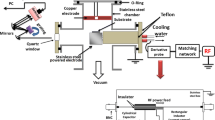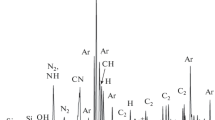Abstract
Many types of carbon films are being investigated for use in many different applications for their electrical, mechanical, and optical properties. Organic based plasmas are beginning to be used for the production of a wide variety of novel film stacks. The use of these stacks can range from sensor to dielectrics for flexible electronics to biocompatible surfaces. Knowledge of how these films actually grow is largely unknown. In light of this, we have performed Fourier transform infrared (FTIR) spectroscopy to the study of hexane plasmas. We use this diagnostic to identify different plasma-produced daughter species produced from n-hexane. For example, we observe the creation of methane, ethylene, and acetylene. From this we develop a likely dissociation model for the parent gas.






Similar content being viewed by others
References
Beake B, Zheng S, Alexander M (2002) J Mater Sci 37:3821
Möller W (1993) Appl Phys A 56:527
Cui F, Li D (2000) Surf Coat Technol 131:481
Donnet C (1998) Surf Coat Technol 100–101:180
Hargis P Jr, Greenberg K, Miller P, Gerardo J, Torczynski J, Riley M, Hebner G, Roberts J, Olthoff J, Whetstone J, Van Brunt R, Sobolewski M, Anderson H, Splichal M, Mock J, Bletzinger P, Garscadden A, Gottscho R, Selwyn G, Dalvie M, Heldenreich J, Butterbaugh J, Brake M, Passow M, Pender J, Lujan A, Elta M, Graves D, Sawin H, Kushner M, Verdeyen J, Horwath R, Turner T (1994) Rev Sci Instrum 65:140
Jindal A, Prengler A, Overzet L, Goeckner M (2006) J Vac Sci Technol A 24:126
Padron-Wells G, Jarvis B, Jindal A, Goeckner M Chemistry of di (ethylene glycol) vinyl ether pulsed plasmas for development of biocompatible thin films. Colloids Surf B: Biointerfaces (in press)
Fourches N, Turban G (1996) Plasmas Polym 1:47
Beake B, Leggett G, Alexander M (2001) Polymer 42:2647
Sharpe S, Johnson T, Sams R, Chu P, Rhoderick G, Johnson P (2004) Appl Spectrosc 58:1452
Chandrashekar A, Lee J, Lee G, Goeckner M, Overzet L (2006) J Vac Sci Technol A 24:1812
Ramachandran S (2008) Study of diamond like carbon as a template for nanoimprint lithography and as a filler material for vertically aligned carbon nanotube forests. Doctoral dissertation, University of Texas at Dallas
Lieberman M, Lichtenberg A (1994) Principles of plasma discharges and materials processing. Wiley, New York
Wild C, Wagner J, Koidl P (1987) J Vac Sci Technol A 5:2227
Gengenbach T, Vasic Z, Chatelier R, Griesser H (1994) J Polym Sci A 32:1399
Author information
Authors and Affiliations
Corresponding author
Rights and permissions
About this article
Cite this article
Pierce, R.G., Padron-Wells, G. & Goeckner, M.J. Gas-Phase Chemistry of Pulsed n-Hexane Discharge. Plasma Chem Plasma Process 29, 1–11 (2009). https://doi.org/10.1007/s11090-008-9157-8
Received:
Revised:
Accepted:
Published:
Issue Date:
DOI: https://doi.org/10.1007/s11090-008-9157-8




